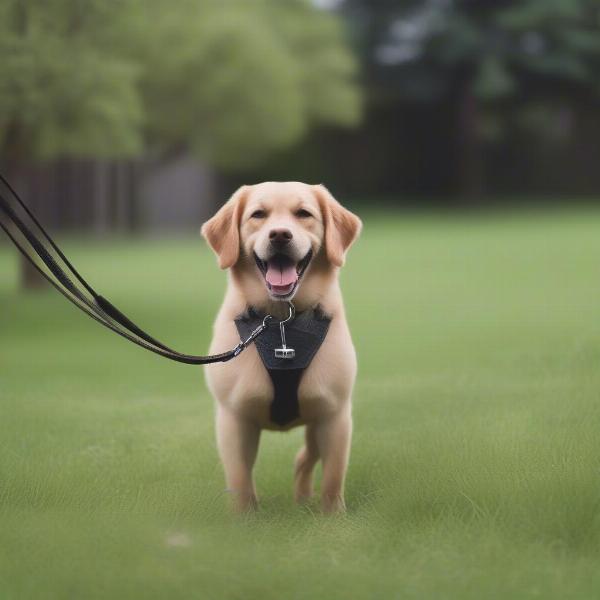Many dog owners experience the frustration of their furry friend refusing to poop while on a leash. This can lead to uncomfortable walks, digestive issues for the dog, and a general sense of bewilderment. Why does this happen, and more importantly, what can you do about it? This article will explore the reasons behind this common canine quirk and offer practical solutions to help your dog feel comfortable relieving themselves on a leash.
Understanding Why Your Dog Won’t Poop on Leash
There are several reasons why your dog might be holding it in during walks. Some dogs feel vulnerable in this position, as they are restricted and can’t easily flee if they feel threatened. Others may simply be distracted by the sights and sounds of the environment. For puppies, it can be a matter of learning and adapting to a new routine. Finally, a negative past experience, like being startled while eliminating on leash, could also be the culprit.
Privacy and Vulnerability
Dogs, like humans, appreciate a bit of privacy when doing their business. Being on a leash can make them feel exposed and vulnerable. Imagine having to perform a private act while tethered to someone – not exactly a comfortable scenario!
Distractions and Over-Stimulation
The exciting world outside can be overwhelming for some dogs. The smells, sounds, and sights can be so stimulating that they forget their bodily needs. They might be too busy sniffing every lamppost or watching other dogs to focus on pooping.
Lack of Routine and Training (Especially for Puppies)
Puppies are learning about the world, and sometimes, that includes learning where and when it’s appropriate to go potty. Consistency with potty breaks and positive reinforcement can go a long way in establishing good habits.
Past Negative Experiences
If your dog has had a negative experience while pooping on a leash, such as being scolded or startled, they might associate leash walks with anxiety and avoid going to the bathroom.
How to Help Your Dog Poop on Leash
Now that we understand the potential reasons, let’s dive into some practical solutions. Patience and consistency are key, as this may take some time and effort.
Creating a Comfortable Environment
Choose a quiet, less-trafficked area for potty breaks. A familiar spot can also help ease your dog’s anxiety. Try walking further from your usual path to find a more secluded spot.
Establishing a Routine
Stick to a regular potty break schedule, even if your dog doesn’t go. This helps establish a predictable routine and can signal to your dog that it’s time to eliminate.
Positive Reinforcement
When your dog does poop on the leash, reward them with praise, treats, or a favorite toy. This positive association will encourage them to repeat the desired behavior.
Using Verbal Cues
Choose a verbal cue like “go potty” and use it consistently during potty breaks. Over time, your dog will associate the cue with the action.
Increasing Exercise
A longer walk or playtime before a potty break can stimulate your dog’s bowels and increase the likelihood of them needing to go.
Addressing Underlying Medical Issues
If your dog’s refusal to poop on leash is a sudden change, consult your veterinarian to rule out any underlying medical conditions.
 Dog on Leash in Quiet Area for Potty Break
Dog on Leash in Quiet Area for Potty Break
Conclusion
Dealing with a dog that won’t poop on leash can be frustrating, but with patience and understanding, you can overcome this challenge. By creating a comfortable environment, establishing a routine, and using positive reinforcement, you can help your dog feel more relaxed and confident about eliminating on leash. Remember that each dog is an individual, so finding the right approach may require some experimentation. Don’t hesitate to consult a professional dog trainer or veterinarian if you continue to experience difficulties.
FAQ
- How long should I wait for my dog to poop on a leash? Give your dog at least 10-15 minutes in a quiet spot.
- What if my dog still won’t poop after trying these tips? Consult a veterinarian or professional dog trainer for personalized advice.
- Could my dog be constipated? If your dog hasn’t pooped in several days or is showing signs of discomfort, consult a veterinarian.
- Is it okay to let my dog poop in my yard and then go for a walk? This can be a good solution for dogs who struggle with pooping on leash.
- Can medications help my dog poop on a leash? While there are no medications specifically for this issue, a vet might suggest solutions for underlying anxiety or digestive problems.
- Should I scold my dog for not pooping on a leash? No, scolding will only make your dog more anxious and exacerbate the problem.
- Can changing the type of leash help? A longer leash can provide more freedom and reduce your dog’s sense of restriction.
ILM Dog is a leading online resource for dog owners worldwide, offering expert advice on all aspects of canine care, from breed selection to senior dog care. We are dedicated to providing practical and reliable information to help you nurture your furry companion. If you’re struggling with your dog refusing to poop on a leash, or have any other dog-related concerns, our experts can help. Contact us today via email at [email protected] or call us at +44 20-3965-8624. ILM Dog provides expert guidance on various aspects of dog care, including behavior, nutrition, and health.